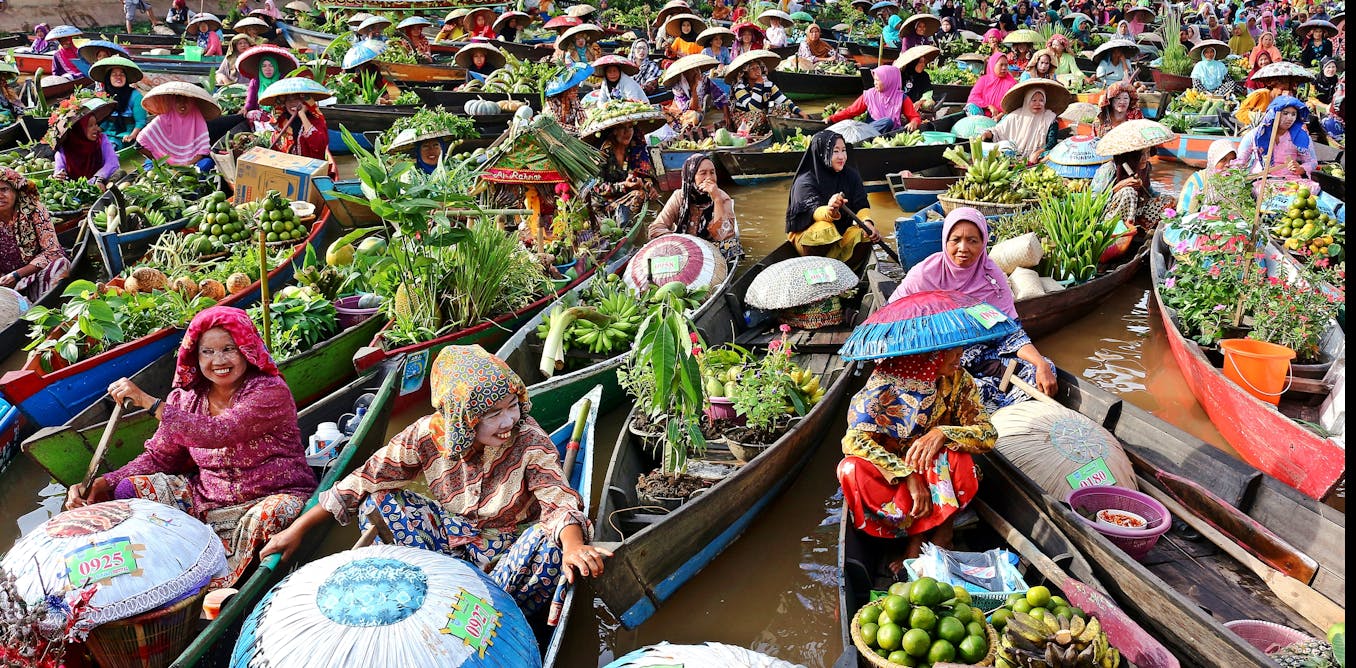Indonesians are consuming more and more processed foods, including sugary drinks, salty snacks, junk food, and unhealthy fats.
These changes take a toll on people’s health, as well as the environment.
There is growing evidence consumption of highly processed and preserved foods is linked with poorer health outcomes and higher risk of mortality. A 2019 study using national health data found consuming sugary drinks is associated with an increased risk of excess weight and obesity among children and adolescents.
A 2021 research has predicted the growing consumption of sugar and meat in Indonesia will impact the environment.
As food system and sustainability researchers, we recommend Indonesians look back at our local food biodiversity for a healthier and more sustainable way to eat.
What healthy local foods do we have?
Indonesia’s rich mix of cultures is reflected in the variety of its food habits and dishes. A study by the Ministry of Environment and Forestry of Indonesia showed that Indonesians consume at least 100 types of carbohydrates, 100 types of legumes, 450 fruits, and 250 types of vegetables and mushrooms.
For example, some Indonesians eat beans and seeds, such as red beans mixed with sorghum, cooked and pressed using banana leaves and served as local staple food.
Some Indonesians even eat insects. Studies show insects have high levels of protein and micronutrients, making them a great source of nutrition. Scientists around the world are studying insects for their potential to be low-carbon animal source foods, even named it as “future food”.
Indonesia’s seascapes is also the home of the largest marine biodiversity in the world, with almost 3,000 species found in the markets of Java, Bali, and Lombok alone.
Fish from warm tropical seas like Indonesia contain high calcium, iron and zinc.
There are many regions in Indonesia that have diverse locally produced foods that are healthy, yet underutilized.
Why the local foods?
Focusing on local foods is a beneficial approach to achieving healthy and sustainable diets, for the following reasons:
First, the diversity of Indonesian local foods, is a gateway to diverse diets. When people eat a diverse range of foods, it helps them get all the nutrients they need and can better reduce the risk of child stunting.
Recent studies have shown that consuming a variety of species daily also promotes better micronutrient adequacy. Look no further, Indonesia’s megabiodiversity holds the key to a more nourished country.
Second, indigenous plant-based and animal-source foods that suit local conditions tend to be more resilient to climate shocks, such as extreme weather or floods.
One example is sago, which can grow in prolonged droughts and floods in areas such as Sulawesi, Papua and Maluku.
Additionally, sago is considered a healthier carbohydrate option because it has lower glycemic index, and can function as a prebiotic, which means they stimulate the growth of healthy bacteria in the gut.
Third, eating local food could cut back carbon emissions from packaging and distribution. This is particularly important for items that are easily spoiled, like fish and vegetables, and for highly processed foods that contribute 10% of emissions in the food sector.
As an archipelagic country with about 6,000 inhabited islands, a shorter and more efficient food distribution system could cut back food loss and waste along the supply chain.
Fourth, promotion of eating local food has the potential to increase environmental awareness and social justice by increasing interaction between producers and consumers.
In some cases, such promotion supports producers in growing underutilized food species. We can link efforts to conserve biodiversity with the nutritional benefits of the food we eat. This can be achieved by promoting the consumption of locally sourced food, which not only improves people’s diets but also helps preserve biodiversity by encouraging them to protect their food sources.
It could also help boost culinary tourism, which is increasingly popular in Indonesia. Additionally, local food are also part of local cultures and practices. Promotion of healthy and sustainable diets through foods they are familiar with, promise a better uptake by the local communities.
How to promote healthy and sustainable diets through local foods
To promote healthy and sustainable diets in Indonesia, we need to consider global, national, and local factors.
We can draw inspiration from global initiatives like the Planetary Health Diet,– a global reference diet made by group scientists from many countries. However, we should not apply such references rigidly, as Indonesia has its own unique characteristics.
Fortunately, the Indonesian government has dietary guidelines called Isi Piringku or “My Plate Initiative” that help people balance their diets by eating the right amount of carbohydrates, protein, fruits and vegetables. A study published in the British Medical Journal found “Isi Piringku” was not only one of the healthiest global dietary guidelines, but also among the most environmentally sustainable out of 85 evaluated.
At the local level, we need more efforts to use traditional food cultures to implement the “Isi Piringku” concept in each area of Indonesia. Nutrition experts can make a big difference by using knowledge of local food to create healthy “Isi Piringku” meals.
People may think local foods aren’t nutritious because we don’t know enough about them and all the different options available.
This is where research and documentation of local foods come in – to show the variety and true value of local foods to health and culture.
We need to gather more information about the rich food biodiversity and local food practices in different parts of Indonesia. We need to learn more about how these plants grow, where they are usually found, who consumes them, how to prepare them for consumption, the cultural significance, nutritional value, and health benefits.
This pool of knowledge will provide a strong basis for healthy and sustainable national dietary programs.

The post “How eating a local diet can help Indonesians live healthier and more sustainable lives” by Mulia Nurhasan, Food and Nutrition Scientist, CGIAR System Organization was published on 03/30/2023 by theconversation.com



































